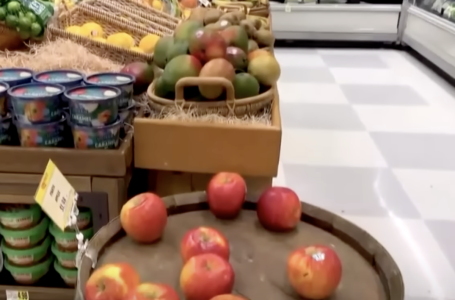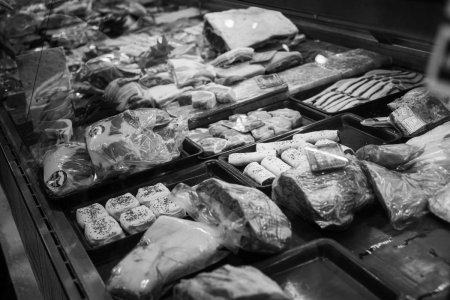Will Trump’s tariffs make groceries more expensive? Here’s what some experts think
By
Veronica E.
- Replies 0
With grocery prices already feeling higher than they used to, many Americans are keeping a closer eye on what might drive costs up even more.
Recently, President Trump proposed a new set of tariffs—essentially taxes on imported goods—that has reignited debate about how trade policies affect everyday consumers.
While these discussions often play out in political circles or business news, they have real-life consequences at the checkout line.
For Americans trying to make the most of every dollar, especially on essentials like food, it’s natural to wonder: could this mean another bump in the weekly grocery bill?
While expert opinions differ, some economists say the answer is yes—at least for certain imported items.
From coffee and seafood to bananas and olive oil, some of the foods Americans rely on every day could be affected.
In this article, we’ll take a closer look at what’s being said, what it could mean for your grocery bill, and how to stay prepared if prices start to shift.

Tariffs are taxes on imported goods, and their purpose is usually to protect domestic industries.
But when it comes to groceries, the effects can be more complicated.
As David Ortega, a food economist at Michigan State University, explained, “The short answer is yes, prices are going to go up. They may not skyrocket for all imported products, but they will go up. Tariffs are a tax on imports, so by definition, they are inflationary.”
Ortega added that the tariff itself only applies to the value of the product at the border.
Other costs—like transportation, storage, and retail markup—are not affected directly, so consumers might not always see a one-to-one increase.
Still, prices tend to rise.
According to the Consumer Federation of America, citing data from the US Food and Drug Administration, about 15% of the food supply in the US is imported.
That includes:
Some items, such as bananas and coffee, are almost entirely sourced from abroad.
“We rely on international trade and imports for agricultural products in order to meet year-round consumer demand for a lot of these items,” Ortega said.
He noted that the US can’t grow certain products domestically—or only seasonally—making imports the more practical or affordable option in many cases.
Foods that are heavily imported are likely to be the most affected. Ortega pointed to bananas, coffee, and olive oil as examples:
Seafood could also be impacted, said Michael Swanson, Chief Agricultural Economist at Wells Fargo’s Agri-Food Institute.
In many cases, seafood caught in the US is sent to China for processing—then imported back for sale.
Swanson raised concerns about whether this process could result in multiple layers of tariffs.
“Will it be tariffed going in [to China], tariffed coming out, and then it will become uneconomical for everybody?” he asked.
Even if a product is made in the US, you might still see higher prices.
Chris Costagli, vice president and food insights lead at NielsenIQ, explained that manufacturers track something called “industry price gap management.”
That means if competitors raise prices due to tariffs, US-made brands may follow suit just to match market trends.
In addition, Costagli pointed out that imported packaging or ingredients could affect the final price of a US-produced item.
“A food product may be made in the United States, so it doesn’t have a tariff levied on it, but the packaging or other ingredients to make the food may be imported,” he said.
While many imported products are expected to rise in cost, some US goods could see price drops—at least temporarily.
Swanson said that the US exports roughly 15% of its poultry and 20% of its pork.
If foreign markets pull back due to tariffs, the extra supply may stay in the US and bring prices down at home.
“We might actually see pork and poultry prices come down,” he said.

Thomas Gremillion of the Consumer Federation of America warned that the impact of these tariffs would likely fall hardest on those who already spend a larger portion of their income on food.
“The 10% ‘default’ tariffs alone represent a truly historic federal tax increase, maybe the largest in my lifetime, with a highly regressive impact,” he said.
He also pointed to the ripple effect tariffs may have on food production and access.
“For consumers, this can mean added difficulties in managing a food budget. For food companies, this means havoc on supply chains that could lead to more food waste and more food safety risk.”
A recent NielsenIQ study found that while most Americans are aware of tariffs, many remain unsure of how they work.
Ortega said that even some food covered under trade agreements like the United States-Mexico-Canada Agreement (USMCA) may still be subject to tariffs if importers choose not to go through the lengthy verification process.
“A lot of people just have no idea what is tariffed and what isn’t,” Costagli added.
Experts recommend a few ways to help soften the impact if food prices rise:
Tariff policy is complex and can shift quickly, making it hard to predict exactly which items will be affected—or by how much.
But with expert insight and smart shopping strategies, consumers can stay prepared and navigate rising prices with a little more confidence.
Read next: Worried about the economy? These tips can help you retire with confidence

Have you noticed changes in food prices lately? Are you adjusting how you shop? Let us know in the comments—your insight might help other readers find new ways to save.
Recently, President Trump proposed a new set of tariffs—essentially taxes on imported goods—that has reignited debate about how trade policies affect everyday consumers.
While these discussions often play out in political circles or business news, they have real-life consequences at the checkout line.
For Americans trying to make the most of every dollar, especially on essentials like food, it’s natural to wonder: could this mean another bump in the weekly grocery bill?
While expert opinions differ, some economists say the answer is yes—at least for certain imported items.
From coffee and seafood to bananas and olive oil, some of the foods Americans rely on every day could be affected.
In this article, we’ll take a closer look at what’s being said, what it could mean for your grocery bill, and how to stay prepared if prices start to shift.

Proposed tariffs on imported goods have sparked discussion about how trade policies might influence grocery prices in the US. Image Source: YouTube / CBS News.
What are tariffs—and how do they affect food?
Tariffs are taxes on imported goods, and their purpose is usually to protect domestic industries.
But when it comes to groceries, the effects can be more complicated.
As David Ortega, a food economist at Michigan State University, explained, “The short answer is yes, prices are going to go up. They may not skyrocket for all imported products, but they will go up. Tariffs are a tax on imports, so by definition, they are inflationary.”
Ortega added that the tariff itself only applies to the value of the product at the border.
Other costs—like transportation, storage, and retail markup—are not affected directly, so consumers might not always see a one-to-one increase.
Still, prices tend to rise.
How much of our food is imported?
According to the Consumer Federation of America, citing data from the US Food and Drug Administration, about 15% of the food supply in the US is imported.
That includes:
- 32% of fresh vegetables
- 55% of fresh fruit, and
- a staggering 94% of seafood
Some items, such as bananas and coffee, are almost entirely sourced from abroad.
“We rely on international trade and imports for agricultural products in order to meet year-round consumer demand for a lot of these items,” Ortega said.
He noted that the US can’t grow certain products domestically—or only seasonally—making imports the more practical or affordable option in many cases.
Also read: Tariffs on the rise: Experts warn of sharp price hikes—here’s what you can do
Which foods are most at risk for price increases?
Foods that are heavily imported are likely to be the most affected. Ortega pointed to bananas, coffee, and olive oil as examples:
- Bananas: Nearly all come from Central and South America.
- Coffee: Outside of Hawaii and Puerto Rico, the US doesn’t produce enough to meet demand.
- Olive oil: While some is produced in California, most comes from Europe.
Seafood could also be impacted, said Michael Swanson, Chief Agricultural Economist at Wells Fargo’s Agri-Food Institute.
In many cases, seafood caught in the US is sent to China for processing—then imported back for sale.
Swanson raised concerns about whether this process could result in multiple layers of tariffs.
“Will it be tariffed going in [to China], tariffed coming out, and then it will become uneconomical for everybody?” he asked.
Also read: Car insurance rates are climbing fast—where you live might be driving up the bill
Why even American-made foods might get pricier
Even if a product is made in the US, you might still see higher prices.
Chris Costagli, vice president and food insights lead at NielsenIQ, explained that manufacturers track something called “industry price gap management.”
That means if competitors raise prices due to tariffs, US-made brands may follow suit just to match market trends.
In addition, Costagli pointed out that imported packaging or ingredients could affect the final price of a US-produced item.
“A food product may be made in the United States, so it doesn’t have a tariff levied on it, but the packaging or other ingredients to make the food may be imported,” he said.
Could some prices actually come down?
While many imported products are expected to rise in cost, some US goods could see price drops—at least temporarily.
Swanson said that the US exports roughly 15% of its poultry and 20% of its pork.
If foreign markets pull back due to tariffs, the extra supply may stay in the US and bring prices down at home.
“We might actually see pork and poultry prices come down,” he said.

Experts say prices for poultry and pork could shift depending on how tariffs affect export markets and domestic supply. Image Source: Pexels / Matt Webster.
Also read: Secondhand fashion may outsmart tariffs—and save your wallet
Why lower-income households may feel it most
Thomas Gremillion of the Consumer Federation of America warned that the impact of these tariffs would likely fall hardest on those who already spend a larger portion of their income on food.
“The 10% ‘default’ tariffs alone represent a truly historic federal tax increase, maybe the largest in my lifetime, with a highly regressive impact,” he said.
He also pointed to the ripple effect tariffs may have on food production and access.
“For consumers, this can mean added difficulties in managing a food budget. For food companies, this means havoc on supply chains that could lead to more food waste and more food safety risk.”
Confusion around what’s taxed—and what isn’t
A recent NielsenIQ study found that while most Americans are aware of tariffs, many remain unsure of how they work.
Ortega said that even some food covered under trade agreements like the United States-Mexico-Canada Agreement (USMCA) may still be subject to tariffs if importers choose not to go through the lengthy verification process.
“A lot of people just have no idea what is tariffed and what isn’t,” Costagli added.
How to save at the store
Experts recommend a few ways to help soften the impact if food prices rise:
- Buy American: Look for foods grown and produced in the US—there are often domestic alternatives to popular imports.
- Swap products when needed: Consider Wisconsin-made parmesan or Kentucky bourbon as affordable stand-ins for pricier imports.
- Watch out for shrinkflation: Pay attention to unit prices—some manufacturers shrink packages instead of raising prices.
- Stick to your list: Avoid falling for flashy sales on items you don’t need.
- Explore frozen, dried, or canned options: These can be just as nutritious as fresh foods and may avoid tariff-related price hikes.
- Check store brands: Private-label products are often made in the same facilities as name brands, just at a lower price.
Tariff policy is complex and can shift quickly, making it hard to predict exactly which items will be affected—or by how much.
But with expert insight and smart shopping strategies, consumers can stay prepared and navigate rising prices with a little more confidence.
Read next: Worried about the economy? These tips can help you retire with confidence
Key Takeaways
- Experts including David Ortega, Thomas Gremillion, Michael Swanson, and Chris Costagli say proposed tariffs could increase the price of many everyday foods—especially imports like coffee, seafood, and bananas.
- Even domestically produced items may see price hikes due to imported ingredients, packaging, or industry pricing strategies.
- Roughly 15% of the US food supply is imported, with particularly high percentages in fresh fruit and seafood.
- Smart substitutions, unit price comparisons, and buying American-made products can help reduce the impact on your grocery budget.
Have you noticed changes in food prices lately? Are you adjusting how you shop? Let us know in the comments—your insight might help other readers find new ways to save.






